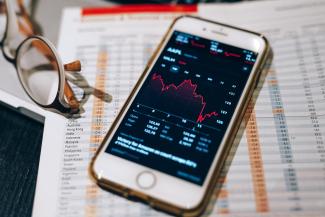
SFM 2nd Quarter Update
Market Synopsis: Second Quarter 2022
The second quarter of 2022 continued with the stock and bond market declines that we experienced in the first quarter of 2022. Inflation in the US has stayed stubbornly high for the time being, and while it has shown signs of topping out and will likely decline in the future, the uncertain timing causes investors to worry. The US Federal Reserve is attempting to curb inflation by raising interest rates, which has the effect of slowing down the economy and possibly pushing us into a recession. The bond market has already adjusted to the expectations that the Fed will raise interest rates by another 1.5% to 2% over the next year. This rise in interest rates can be good for bond investors (including the bonds in your SFM portfolio) as you will now receive higher annual income in the future, but this reset has caused a temporary decline in the prices of these bonds, as shown by the US Aggregate Bond index decline of -4.7% in the second quarter of 2022 and -10.3% in 2022 year-to-date. A number of concerns has also led to a reset in the stock market this year. The market is most concerned with higher inflation (especially due to the war in Ukraine causing uncertainty in food and energy prices), the slowdown in the global economy, and the possibility of a rise in unemployment and a decline in the housing market.
The increasing possibility of the US entering a recession, likely a mild recession, is being factored into stock prices and these worries have caused the decline in the stock market to continue. The US stock market, represented by the S&P 500 large company index, declined in the second quarter by -16.1%, the technology-heavy Nasdaq Composite index lost -22.4% in the quarter, and the US small company Russell 2000 index declined by -17.2%. International stock markets experienced many of the same concerns, causing the Foreign Developed Markets EAFE index to decline by -14.3% and the Emerging Markets index to drop by -12.4%. This brings the 2022 year-to-date return to -20.0% on the S&P 500 Index and -29.5% on the Nasdaq Composite Index, meaning we have officially entered a bear market.
As we mentioned in our last Market Synopsis from the First Quarter of 2022, alternative investments are an important part of our SFM investment strategy and we have prioritized adding a variety of alternative investments to your portfolio over the last 5 years especially. These alternative investments which include private real estate, gold, structured products, and private debt have increased your overall portfolio return while also reducing the portfolio risk and the volatility in the value of your investment accounts. This diversification has helped over the last few years, but as we expected it has been especially beneficial during 2022 as most of these alternative investments have risen in value in the second quarter of 2022 and year-to-date and helped to serve as a ballast to your portfolio protecting it from larger losses. Similar to the first quarter, the strongest performing section within the alternative category in the second quarter was private real estate as all of our holdings earned solid gains in the quarter including the Blackstone Real Estate Income Trust +3.5%, the Starwood Real Estate Income Trust +4.6% (if owned for the full quarter), the Apollo (formerly named Griffin) Diversified Real Estate Fund +0.5%, and the Bluerock Multi-Manager Real Estate Fund +6.2% (if owned for the full quarter). In addition, private debt performed well in the quarter led by the gain in the Cliffwater Corporate Lending Fund +0.7%.
However, as with any category these alternatives investments do not all move in the same direction at all times, and so not all of the positions appreciated during the quarter. The price of Gold declined by -6.8% in the quarter as investors rotated away from this safe-haven investment primarily due to the rise in the value of the US dollar compared to other currencies. Another laggard was the private debt investment Blackstone Secured Lending Fund, which is well-positioned for this environment and earns annual income of over 9% that rises along with interest rates.
Despite the broad based sell-off in the quarter, many of the individual stocks in our client accounts outperformed the overall index returns. Some stocks that fared better than others included the snack food and beverage giant PepsiCo +0.3%, one of the world’s clean energy leaders NextEra Energy -8.1%, the home improvement retailer Home Depot -7.7%, the health sciences laboratory equipment leader Thermo Fisher Scientific -8.0%, and the world’s largest food company Nestle -9.1%, which is based in Switzerland. Meanwhile, some individual stocks lagged the index such as the online retailer and cloud computing leader Amazon.com -34.8%, the alternative investment manager Blackstone (despite very strong gains on the investments that it manages) -27.3%, the social media firm Meta Platforms (formerly known as Facebook) -27.5%, the online payments company Paypal Holdings -39.6%, and the orthopedic implant leader Stryker -25.6%.
As I mentioned above, the US bond market continued to decline in the quarter as inflation stayed high and the US Federal Reserve continued to raise interest rates in an attempt to reduce inflation in the future. Despite the loss on the US bond market index of -4.7% in the quarter, many of the bond positions in our client portfolios outperformed including the WisdomTree Floating Rate Treasury ETF +0.1%, the SPDR Bloomberg 1-3 Month T-Bill ETF +0.1%, the Royal Bank of Canada Inflation-Protected Bond +1.1%, the Rational Special Situations Income Fund -2.7%, and the Thompson Bond Fund -3.2%. At the same time, the bond funds paying the highest annual income underperformed in the quarter as investors indiscriminately sold these investments due to recession concerns. These positions include the PIMCO Flexible Credit Income Fund, which we reduced during the quarter and returned -9.8% despite the annual income it pays increasing to +9.6%/year. It also includes a similar fund managed by the same team at PIMCO called the PIMCO Dynamic Income Fund, which returned -11.8% despite now paying a very high annual income of +12.7%/year.
As we have mentioned many times before, but it bears repeating, when investing it is important to focus on long-term returns and not the movement in price over short periods of time. Investing involves taking risk, and the downside volatility we have experienced this year is a “feature” of investing that we need to live with to earn strong returns over time. As the investor Robert Arnott stated "In investing, what is comfortable is rarely profitable." Unfortunately, you cannot earn large profits over time while taking low risk and staying too safe, as it is the risk of loss that leads to large portfolio gains. Our goal is to design a customized portfolio for you that maximizes potential returns while matching your personal tolerance for risk. The best investment strategy can turn into the worst if you don't have the stomach to see it through.
We appreciate the continued trust you place in us, and we welcome any thoughts or comments that you have.
Chris, Glenn, Sam, David, and Molly

